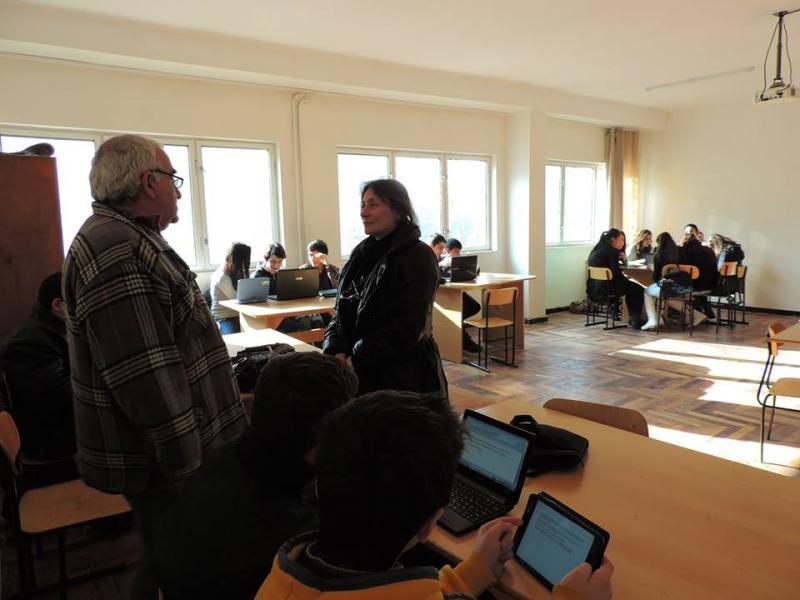The suggested way of organizing education is based on the following principles:
· The High School teacher is a specialist acting in his/her field with his/her own interests and programs.
· The High School learner has educational goals and the school has been chosen as a means for the realization of part of these goals.
· The High School learner assumes liabilities to meet the requirements for the school leaver defined by the state standards.
· Education becomes effective in case of collaboration.
· The learner should be helped when he/she needs it and turns to the teacher for it.
· Learning is effective when the learner wants to learn.
The High School is a center of working study rooms. The study room is a working room for each teacher. A timetable is formed where the teacher’s working hours and the study room are mentioned (according to the working hours of a given teacher). The teacher works in the study room during the hours mentioned in the timetable.
The teacher:
· does his professional, creative, research work.
· does division of work among the learners
· helps te learner in case of necessity (when the learner turns to him/her).
· organizes examinations (informing about it in advance).
· Conducts his/her weekly seminars (the work done by the teacher, learner and master class lessons).
· Registers the learners who work at his/her study room.
The learner comes to school to work having decided what to do, when to do and where to do.
He/she:
· goes into the study room to work.
· has a personal working tool.
· keeps the reading-room rules.
· Turns to hhis/her friend or teacher for help in case of necessity
· Tells the teacher when he/she wants to leave the study room.
· Knows that he/she is to cover the working hours during the week allocated by the (no matter in which study room); should allocate the minimum quantity of hours to each school course according to the curriculum (the courses and minimum quantity of hours allocated to them are determined in the individual curriculums of the learners).
Difficulties
· Shortage of teachers carrying out professional, creative and research work.
· Difficulty for the teachers in getting rid of their traditional image (the one who teaches) and in displaying the ability to manage a working group.
· Difficulty in including the requirements for the school leaver, defined by the state standards, in the work done by the learners
· There may be study rooms which the learners will not attend (the right of learners’ free choice); Natural selection of teachers will be carried out.
· There may be a learner who will not attend any study room; Natural selection of learners will be carried out (we should get rid of such “not learning” learners; Now we have some learners who are only physically present at the lessons: they are either busy with something else or are disturbing their friends and the teacher).
Advantages
· Such concepts as lessons, breaks, being late for classes and being absent are eliminated (being busy with a determinate course, in a determinate group, at a determinate time under compulsion and having a rest together is eliminated).
· The learner gets used to spending his/her time effectively (he/she may long be engaged in work he/she is interested in depending on his/her working plans: for example, a learner of Grade 12 who has decided to go to American University and is to take exams in Math and English in December or January, may be engaged in studying only these two subjects during the first four months with a determination to cover up the rest of the subjects in the second term).
· We register what the learner has done: came, took part, did (now we are registering what the learner hasn’t done: was late, was absent, didn’t do, disturbed)
· Each learner is given a chance to work at his own pace.
· It is convenient to work in groups.
· The teacher gets an opportunity to effectively use his working time defined by the contract.
· The teacher gets an opportunity to perform professional research work and to involve the learners in that work and publish the results of that work.
P.S.1: I haven’t published the whole list of the advantages and difficulties so that the learners can have the opportunity to create.
P.S. 2: We tried to apply this way of organizing our trainings at High School during the winter camp of the year 2015, January 23-26. We haven’t yet analized the work at the camp, but it was obvious for me that I hadn’t presented it to the teachers in a proper way. They were not prepared to organize their work in that way. Most of the learners don’t have their own plan of work (they think in a casual way, “It’s simply a lesson, let the teacher think what I should do.” But according to the new way of organizing work the learner himself/herself should plan his/her work before coming to school to “work”). There were also positive signals: Narek sahakyan, a student of Grade 11, on behalf of several students expressed a pity that we hadn’t organized our review camp that way. Yura Ganjalyan writes about Gor Khachatryan, a student of Grade 11: “He was the only learner during the winter camp who spent those days purposefully. He used to come to my study room and we spoke English for 3-4 hours. He was thinking that he would be engaged in Math the next week.”
Translator: Yura Ganjalyan

